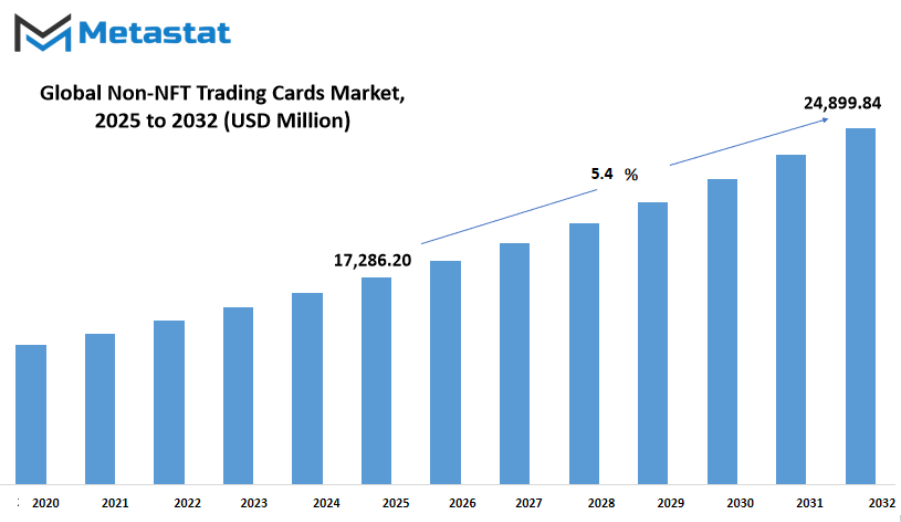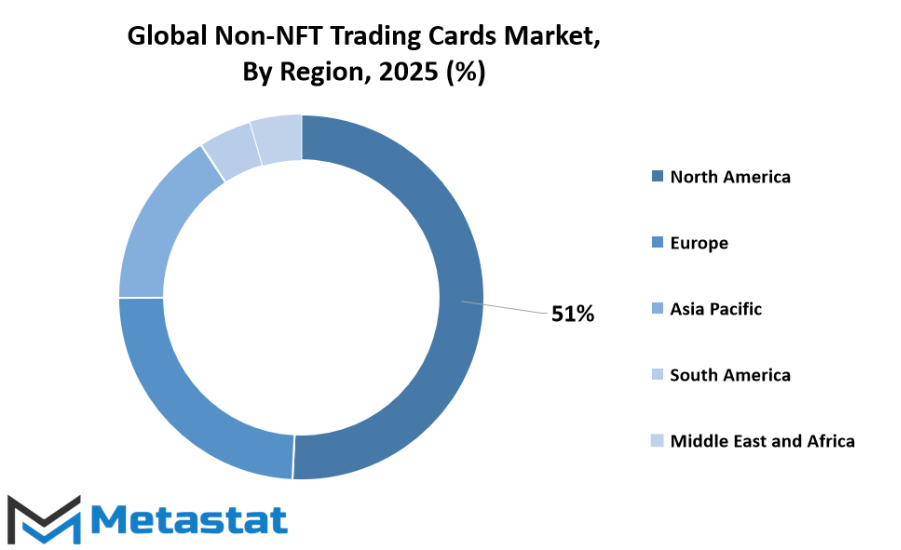MARKET OVERVIEW
The global non NFT trading cards market will keep adding to decades of cultural significance, artistic creativity, and collector passion. In contrast to the online gold rush into blockchain-backed assets, this market will maintain its foundation in physical design and material ownership. The existence of a card that can be held, displayed, and traded without the need for digital servers will persist in providing a sense of permanence and authenticity that tokens in digital form will not be able to replicate. What characterizes this industry is not merely the printed card itself but the multi-layered history, narrative, and community that have developed around it. Throughout the next several years, this demand will not be fueled purely by nostalgia, though that will continue to prove a mighty influence.
The sensory quality of a card, whether being used within a competitive game or sitting stored in protective sleeves, will generate experiences not possible using digital alternatives. Collectors and players will go after the flaws, the texture, and the smell of just-opened packages in a ritual that online cannot offer. This tactile culture will ground the market and will keep it going no matter how much technology vies for attention. Producers will try out printing methods far more advanced than mere graphics. Foil stamping, holograms applied in layers, and even more subtle three-dimensional effects will transform each card into a small work of art.
Meanwhile, older cards will become even more valuable as historical artifacts, preserving a moment in time when particular athletes, artists, or fictional figures were culturally relevant. The market won't just create new collections but will also enhance its archival nature, making certain pieces cultural artifacts. The industry will also have a social structure that will be hard to match for digital-only experiences. Local stores and events where players come together to trade or compete will continue to be the pillars of the community. These interactions will continue the notion that cards are not just collectibles; they are communally anchored friendships, rivalries, and traditions.
The bodily movement of a card over a table, coupled with looks and talk, will continue to be a symbolic action that a virtual exchange cannot emulate. The market itself will become more global, with interest coming from areas that previously might not have fallen within the traditional trading card culture. The movement of designs, cultural allusions, and art contributions will make it an eclectic environment, one that will continue to grow as successive generations work within the medium. Although technology will have some impact on packaging, printing, and distribution, the core of the business will remain rooted in its physical nature. In the future, Global Non-NFT Trading Cards will not fade into the darkness of virtual collectibles. Rather, they will become testament to the fact that tangible things can be imbued with stories, feelings, and associations that technology cannot replicate by itself. The business will continue to be a bridge between art, game, and memory, providing continuity with the past and a foundation for the future imagination.
Global non NFT trading cards market is estimated to reach $24,899.84 Million by 2032; growing at a CAGR of 5.4% from 2025 to 2032.

GROWTH FACTORS
The global non NFT trading cards market is set to experience significant growth in the years ahead, driven by both emotional and practical factors. One of the most powerful forces supporting this market is nostalgia, as trading cards have long been tied to cherished memories of collecting, exchanging, and building connections around shared interests. The tangible nature of physical cards provides a sense of ownership and collectibility that digital items often fail to replicate. This emotional attachment not only encourages continued purchases but also helps sustain a loyal consumer base across different age groups.
Another major driver of expansion comes from licensing agreements with established sports leagues, entertainment brands, and other popular franchises. These partnerships fuel fan engagement by connecting trading cards to beloved players, teams, and characters. When a card represents a figure that already holds deep cultural value, the collectible becomes more than just a product; it transforms into a meaningful keepsake. This link between fans and their favorite icons ensures that demand will remain steady, especially as global audiences continue to grow.
While these growth factors are strong, there are also serious challenges that could limit progress. Counterfeiting and authenticity fraud represent high risks for both collectors and producers. Fake cards undermine trust in the market and reduce the value of genuine products, creating hesitation among potential buyers. Beyond this, the production and distribution of physical trading cards carry significant logistical demands. Printing, packaging, shipping, and storage contribute to overhead costs that can weigh heavily on manufacturers and distributors, particularly when scaling operations to meet international demand.
To address these hurdles, innovation will play a central role in shaping the future of the global non NFT trading cards market. One promising solution lies in the integration of digital twins, such as QR codes or scannable chips embedded in cards. These features can serve as verification tools, ensuring authenticity while also unlocking digital content and interactive experiences. By bridging the physical and digital worlds, trading cards could gain new layers of utility without losing their tangible appeal. This approach would not only protect collectors but also create fresh opportunities for fan interaction, making each card more valuable than before.
Overall, the global non NFT trading cards market will continue to grow as nostalgia and fan engagement remain powerful motivators. Despite the risks of counterfeiting and high operational costs, advancements like digital twins will provide sustainable solutions and exciting opportunities. With careful innovation, this market is likely to thrive and capture the interest of both long-time collectors and new generations.
MARKET SEGMENTATION
By Type
The global non NFT trading cards market is expected to grow steadily as demand for physical collectibles continues to attract both casual buyers and serious collectors. Trading cards have always held a unique value, and this trend will likely expand as more people search for tangible assets that carry both sentimental and financial worth. Digital assets may dominate certain spaces, but physical trading cards offer a sense of ownership and connection that cannot easily be replaced. The rise of the Global Non-NFT Trading Cards market will be shaped by shifting consumer interests, stronger distribution channels, and a growing appreciation for traditional collectibles that hold long-term value.
The global market is further segmented into Sports Cards, Non-Sports Cards, and Trading Card Games (TCGs). Sports cards will continue to dominate because of long-standing fan bases, historical significance, and the emotional link tied to athletes. Non-sports cards, which include themes like movies, television, and pop culture, will expand as entertainment industries keep introducing fresh content and characters that create new opportunities for card releases. Trading Card Games (TCGs) will see a promising future, with players and collectors seeking both strategic gameplay and collectible appeal. Each category will grow in its own way, reflecting the different reasons people buy and hold onto trading cards.
Technology will also influence the global market. Better printing methods, advanced packaging, and limited-edition releases will attract attention. Online platforms will make buying, selling, and trading easier, connecting global communities of collectors who share common interests. At the same time, physical events such as card shows and tournaments will remain important, giving people direct interaction with cards and other collectors. These in-person experiences will strengthen the bond between trading cards and community culture, which will remain central to market growth.
Looking ahead, the global market will likely benefit from cross-industry partnerships. Sports organizations, film studios, and gaming companies will continue teaming up with card manufacturers to release exclusive sets that appeal to niche audiences. Limited runs and special editions will drive scarcity and demand, ensuring that certain cards maintain or even increase in value over time. The mix of nostalgia, new creative themes, and growing global interest will secure the role of trading cards as both a collectible and investment option.
Overall, the global market will move forward with strong momentum. While consumer behavior may shift over time, the appeal of holding a physical card, whether linked to a favorite athlete, a popular character, or a competitive game, will ensure that the market remains vibrant and relevant for years to come.
By Sports Cards Type
The global non NFT trading cards market is gaining attention as collectors and investors continue to value physical cards for both nostalgic and financial reasons. Unlike digital formats, physical cards provide a tangible connection that many people appreciate, and this factor will continue to influence demand in the years ahead. The Global Non-NFT Trading Cards market will be shaped by shifting consumer preferences, technology-driven authentication methods, and the rising influence of sports culture worldwide.
By Sports Cards Type, the global market is divided into Baseball Cards, Basketball Cards, Football Cards, Soccer/Hockey Cards, Nascar Cards, and Other Sports Cards. Baseball Cards have always held a strong position, especially in North America, where historical collections still drive high valuations. Basketball Cards have shown remarkable growth due to international recognition of popular leagues and star athletes who attract global fans. Football Cards are likely to expand further, as both professional and college-level interest pushes demand for limited editions and rare releases. Soccer and Hockey Cards continue to develop a strong presence, fueled by global tournaments and rising participation in different regions. Nascar Cards, though more niche, retain a dedicated audience that values exclusive designs and commemorative editions. Other Sports Cards will also gain importance as new categories of athletes emerge, broadening the appeal beyond traditional sports.
The global market will increasingly be influenced by technology used in verifying authenticity and condition grading. Modern grading systems, combined with blockchain-style tracking without shifting to NFT formats, will ensure that cards retain value and prevent counterfeiting. This advancement will create greater trust among buyers and sellers, making trading more secure and transparent. At the same time, the secondary market will remain vibrant as collectors seek out rare and vintage cards, often treating them as both a hobby and a form of investment.
Looking toward the future, the global market will also be shaped by cultural shifts and new generations of collectors. Younger audiences who grew up with digital platforms are now showing interest in owning physical memorabilia, creating opportunities for cross-promotional strategies between sports organizations and card manufacturers. Collaborations with global events, player endorsements, and innovative packaging will keep the market appealing and fresh. As distribution channels expand through both online and retail platforms, access will become easier, bringing in collectors from diverse regions.
Overall, the global non NFT trading cards market will continue to evolve with a balance of tradition and innovation. The strong emotional value tied to physical ownership, combined with advancing methods of authentication and grading, ensures that this market will not only sustain but also grow steadily in the future.
By Non-Sports Cards Type
The global non NFT trading cards market is expected to continue expanding as collectors and enthusiasts search for physical connections in an increasingly digital age. While many industries move toward virtual experiences, trading cards that can be held, exchanged, and displayed still carry a special sense of value. This market not only attracts long-time collectors but also appeals to new generations who see trading cards as both entertainment and a potential investment. The strength of this growth lies in the variety of card types that keep the market fresh and constantly engaging.
By Non-Sports Cards Type, the global market is divided into several unique categories. Entertainment Cards, such as those connected with Disney and Marvel, continue to be among the most popular, as they allow fans to celebrate iconic stories and characters. Gaming Cards, which include Pokémon, Magic The Gathering, and Yu-Gi-Oh!, are widely collected because they offer both playability and collectability, creating a dual purpose that keeps demand high. Character Cards remain strong due to their link with beloved fictional figures, while Anime Cards reflect the rising influence of Japanese animation worldwide. Image Cards and Autograph Cards also add layers of variety, as collectors enjoy cards that showcase visuals or signatures tied to cultural moments and personalities.
The future of the global non NFT trading cards market will likely be shaped by a balance between nostalgia and innovation. As technology develops, collectors may see enhanced printing techniques, holographic effects, and limited editions that make cards even more unique. At the same time, entertainment companies will continue to release new franchises, storylines, and characters that fuel the creation of new cards. This constant cycle ensures that there is always something new to pursue while older sets maintain their importance.
A growing factor in the market will be community and social connection. Trading cards bring people together through conventions, tournaments, and online platforms where buying, selling, and exchanging take place. This sense of shared excitement gives physical cards a staying power that digital items often cannot replace. Younger audiences are expected to join older generations in keeping this tradition alive, while also shaping it with their own preferences and interests.
Overall, the Global Non-NFT Trading Cards market shows a future where physical collecting continues to thrive alongside digital entertainment. With diverse card types, strong fan bases, and ongoing innovation, the market will remain a vital part of popular culture and an exciting space for collectors worldwide.
By Trading Card Games Type
The global non NFT trading cards market will continue to show strong potential as traditional card formats remain an important part of both entertainment and collecting. Even with the rise of digital platforms and blockchain-based assets, non-digital trading cards will keep a steady presence. The market will benefit from nostalgia, cultural attachment, and the physical appeal that digital alternatives cannot replace. Collectors and players often value the tangible aspect of holding and exchanging cards, and this will remain a significant driving factor in the coming years.
By trading card games type, the global market is divided as Collectible Card Games and Strategy-Based Card Games. Collectible card games will likely continue to attract a wide audience due to constant updates, expansions, and special editions. Limited print runs and exclusive designs will encourage more demand from dedicated collectors. Strategy-based card games will maintain a strong position as well, with players enjoying the challenge and skill involved in competitive matches. This combination of collectibility and gameplay depth will keep the market appealing to both casual and committed buyers.
Future growth in the global non NFT trading cards market will also be supported by collaborations with popular entertainment franchises. Partnerships with movies, television, anime, and sports will keep fresh content flowing into the market, ensuring long-term interest. Retailers and manufacturers will continue to explore creative packaging and distribution methods, making products more accessible to both new and seasoned buyers. Physical events, such as tournaments and conventions, will also play a role in sustaining excitement and building communities around trading card culture.
Technology will still influence the market even without shifting to digital ownership models. Augmented reality features, companion apps, and online platforms for competitive play will complement physical cards rather than replace them. This hybrid experience will give consumers a balance between traditional collecting and modern interaction. As younger generations discover the appeal of physical collectibles, there will be opportunities to expand the consumer base even further.
The global non NFT trading cards market will also reflect long-term investment trends. Certain rare cards will likely gain value over time, attracting attention from collectors who view them as both hobbies and assets. This perception of future worth will strengthen overall interest in physical card markets. Despite digital alternatives, the importance of physical cards as cultural artifacts will remain strong. The combination of tradition, strategy, and collectability will secure a promising future for the Global market as it adapts and grows within a changing consumer landscape.
|
Forecast Period |
2025-2032 |
|
Market Size in 2025 |
$17,286.20 million |
|
Market Size by 2032 |
$24,899.84 Million |
|
Growth Rate from 2025 to 2032 |
5.4% |
|
Base Year |
2024 |
|
Regions Covered |
North America, Europe, Asia-Pacific Green, South America, Middle East & Africa |
REGIONAL ANALYSIS
The global non NFT trading cards market is gaining attention as collectors and enthusiasts continue to value physical collectibles in an age dominated by digital platforms. This market reflects a blend of tradition and modernity, showing that tangible items still hold strong significance even in a technology-driven future. Trading cards remain popular not only for nostalgic reasons but also for their role as long-term investments. As demand grows, manufacturers and distributors are exploring creative designs, limited editions, and collaborations to meet consumer expectations while expanding the audience base.
Geographically, the global market is spread across multiple regions, each contributing differently to overall growth. In North America, the United States, Canada, and Mexico play a crucial role, with the U.S. standing out as a major hub for trading card production and distribution. The region benefits from a strong collector culture, established retail networks, and frequent promotional events that keep interest alive. Europe also holds a steady position, with the UK, Germany, France, and Italy leading demand while the Rest of Europe continues to show potential for expansion through rising hobby communities and growing online sales platforms.
Asia-Pacific is another region showing remarkable progress. Countries such as India, China, Japan, and South Korea are fueling growth through expanding youth markets and increasing accessibility to global brands. Japan, in particular, has a long history with trading cards, and that cultural foundation continues to inspire new product lines. With online sales channels becoming more advanced, the Rest of Asia-Pacific is expected to present opportunities for further distribution. South America, with Brazil and Argentina at the forefront, reflects a developing market where economic growth and rising middle-class spending power are shaping consumer habits. These countries are likely to see stronger engagement as trading card companies establish better distribution networks.
The Middle East & Africa is gradually entering the global market through markets in GCC Countries, Egypt, and South Africa. Rising urbanization and growing exposure to international entertainment trends will encourage more collectors to participate. Although the region is still in the early stages of adoption, it represents a promising area for expansion.
Looking toward the future, the global non NFT trading cards market will continue to thrive by balancing tradition with innovation. Limited editions, cross-industry collaborations, and integration with digital platforms for authentication will strengthen appeal. Despite the growth of virtual assets, physical trading cards will retain cultural and emotional value, making them a timeless collectible that adapts with changing consumer preferences.

COMPETITIVE PLAYERS
The global non NFT trading cards market has continued to hold an important position in the entertainment and collectibles sector, providing both nostalgic value and opportunities for future growth. Unlike digital tokens, traditional trading cards carry tangible qualities that foster a sense of ownership and personal connection. This connection continues to attract collectors, casual hobbyists, and investors alike, ensuring that demand will not diminish anytime soon. The industry has shown resilience over decades, adapting to changing consumer habits while keeping the appeal of physical cards intact.
Looking ahead, the global market will expand by blending tradition with innovation. Advances in printing, packaging, and design will create products that cater to modern preferences while maintaining the emotional pull of collectible cards. Augmented reality and digital tie-ins may be introduced to enrich the experience without replacing the value of physical ownership. This approach will not only strengthen interest among younger audiences but also retain loyal collectors who value authenticity.
The competitive landscape of the global market highlights the strength of established leaders and the rise of new entrants. Key players such as Bandai Co., Ltd., BBM Co., Ltd., Bushiroad Inc., and Konami Digital Entertainment will continue to influence market direction through popular franchises and innovative releases. Companies like Panini Group, The Pokémon Company, and The Upper Deck Company will further reinforce global dominance by producing widely recognized and highly sought-after collections. Additionally, firms such as Cryptozoic Entertainment, Futera Limited, Kayou, and Select Australia Pty Ltd. will push creative boundaries by offering unique sets that capture the interest of niche audiences. Ravensburger AG, Rittenhouse Archives Ltd., Square Enix Co., Ltd., Tomy Company, Topps (Fanatics Collectibles), TRISTAR Productions, Inc., and Wizards of the Coast will also remain influential by expanding product diversity and strengthening brand loyalty.
Future competition within the global non NFT trading cards market will not solely rely on brand recognition. Success will depend on the ability to merge storytelling, design, and innovation into card sets that resonate with collectors of all ages. Exclusive collaborations, limited editions, and event-based releases will become central strategies to sustain excitement and increase demand. At the same time, companies will need to maintain accessibility to ensure that the hobby continues to grow rather than becoming limited to elite collectors.
Overall, the global non NFT trading cards market will thrive on a balance between tradition and innovation. The involvement of long-standing leaders alongside creative challengers ensures that the future of trading cards will remain dynamic, accessible, and deeply engaging.
Non NFT Trading Cards Market Key Segments:
By Type
- Sports Cards
- Non-Sports Cards
- Trading Card Games (TCGs)
By Sports Cards Type
- Baseball Cards
- Basketball Cards
- Football Cards
- Soccer/Hockey Cards
- Nascar Cards
- Other Sports Cards
By Non-Sports Cards Type
- Entertainment Cards (Disney, Marvel)
- Gaming Cards (Pokémon, Magic The Gathering, Yu-Gi-Oh!)
- Character Cards
- Anime Cards
- Image Cards
- Autograph Cards
By Trading Card Games Type
- Collectible Card Games
- Strategy-Based Card Games
Key Global Non NFT Trading Cards Industry Players
- Bandai Co., Ltd.
- BBM Co., Ltd.
- Bushiroad Inc.
- Cryptozoic Entertainment
- Futera Limited
- Kayou
- Konami Digital Entertainment
- Leaf Trading Cards
- Panini Group
- Ravensburger AG
- Rittenhouse Archives Ltd.
- Select Australia Pty Ltd.
- Square Enix Co., Ltd.
- The Pokémon Company
- The Upper Deck Company
WHAT REPORT PROVIDES
- Full in-depth analysis of the parent Industry
- Important changes in market and its dynamics
- Segmentation details of the market
- Former, on-going, and projected market analysis in terms of volume and value
- Assessment of niche industry developments
- Market share analysis
- Key strategies of major players
- Emerging segments and regional growth potential








 US: +1 3023308252
US: +1 3023308252






